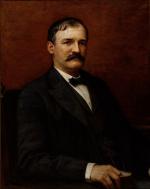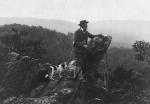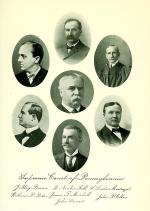![header=[Marker Text] body=[Governor of Pennsylvania, 1895-1899; born, 1849, on a farm 4.5 miles SE of here. During his term, the State Department of Agriculture was created and the present State Capitol planned. Lived most of his life in Bellefonte. Died there in 1903] sign](http://explorepahistory.com/kora/files/1/10/1-A-3B5-139-ExplorePAHistory-a0m8c2-a_450.jpg)
Mouse over for marker text
Name:
Daniel H. Hastings [Politics]
Region:
Valleys of the Susquehanna
County:
Clinton
Marker Location:
Pa. 64 at Pa. 477 NW of Salona
Dedication Date:
October 9, 1950
Behind the Marker
In the days following the botched relief effort after Hurricane Katrina struck New Orleans in 2005, it became easier to understand the popularity of Daniel Hastings. As adjutant general of Pennsylvania, he immediately rushed to the scene of the 1889 Johnstown Flood , when a badly maintained dam burst on the Conemaugh River above Johnstown and killed 2,200 people. Hastings quickly assessed the need for medical supplies and tents, and received nationwide media praise for his work. Within a week, his wife, Jane, had joined a women's corps that distributed aid and cared for the afflicted.
Johnstown Flood , when a badly maintained dam burst on the Conemaugh River above Johnstown and killed 2,200 people. Hastings quickly assessed the need for medical supplies and tents, and received nationwide media praise for his work. Within a week, his wife, Jane, had joined a women's corps that distributed aid and cared for the afflicted.
Before the flood, Hastings was a hardworking but obscure Republican politician who had risen in the ranks in large part thanks to the friendship of a fellow inhabitant of Bellefonte, Centre County, General James A. Beaver. Born into a poor family of nine children in the farming township of Lamar, Centre County, Hastings three times tried to enlist in the Civil War - the first time when he was only twelve - but his father kept bringing him home. A precocious youth, he began teaching school at fourteen while he still worked on the family farm.
James A. Beaver. Born into a poor family of nine children in the farming township of Lamar, Centre County, Hastings three times tried to enlist in the Civil War - the first time when he was only twelve - but his father kept bringing him home. A precocious youth, he began teaching school at fourteen while he still worked on the family farm.
Hastings then became the principal of Bellefonte High School in 1867, when he was only eighteen years of age. While undertaking a study of Latin and Greek, he served as assistant editor of the Bellefonte Republican, and studied law, being admitted to practice in 1875. In 1877, he became a captain in the Pennsylvania National Guard and within a year rose to colonel of his regiment. Meanwhile, he prospered through his investments in banks and coal mines.
In 1880, Hastings nominated Beaver for president at the Republican national convention. Beaver refused the nomination, or to accept presidential candidate James Garfield's offer to be his vice-presidential running mate, but in 1887, while governor of Pennsylvania, he did appoint Hastings adjutant general of Pennsylvania, placing him administratively in charge of the state's National Guard. A powerful speaker, Hastings was chosen to nominate Senator John Sherman of Ohio for president in 1888.
Hastings hoped to succeed Beaver as governor, but neither man was sufficiently pro-business for party boss, United States Senator Matthew Quay. In 1890, Quay instead engineered the nomination of George Delamater, a banker so closely linked with John D. Rockefeller's Standard Oil Company that voters bolted and elected Democrat Robert Pattison to his second term as Pennsylvania's governor. (Pattison, the only Democrat to occupy the Governor's office between 1861 until 1935, also had served as governor between 1883 and 1887.) The Republicans learned their lesson: Beaver himself nominated Hastings in 1894, who then won election by more than 250,000 votes.
Matthew Quay. In 1890, Quay instead engineered the nomination of George Delamater, a banker so closely linked with John D. Rockefeller's Standard Oil Company that voters bolted and elected Democrat Robert Pattison to his second term as Pennsylvania's governor. (Pattison, the only Democrat to occupy the Governor's office between 1861 until 1935, also had served as governor between 1883 and 1887.) The Republicans learned their lesson: Beaver himself nominated Hastings in 1894, who then won election by more than 250,000 votes.
When Hastings took office in 1895 the nation was in the midst of one of the worst economic depressions in American history. Hastings' governorship was distinguished by honesty and moderate reform. With his support, state legislature introduced corporate taxes and established the Pennsylvania Superior Court to relieve the Supreme Court of some of its growing workload. Hastings appointed James Beaver as one of its first seven judges.
In response to the plight of state farmers, Hastings presided over the creation a new Department of Agriculture and the establishment of high schools in rural districts. To address the problem of millions of acres of burnt over land, clear cut and then abandoned by the timber industry, Hastings appointed
high schools in rural districts. To address the problem of millions of acres of burnt over land, clear cut and then abandoned by the timber industry, Hastings appointed Joseph T. Rothrock first Commissioner of the new State Forestry Commission. The two most notable events of Hastings' administration, however, both took place in 1897.
Joseph T. Rothrock first Commissioner of the new State Forestry Commission. The two most notable events of Hastings' administration, however, both took place in 1897.
In February, a fire burned down the state Capitol building. That September, 150 recently deputized Coal and Iron Police under the command of Luzerne County Sheriff James Martin opened fire on some 400 unarmed immigrant miners marching from Harwood to the coal-patch town of Lattimer, killing nineteen and wounding thirty-six others. The Lattimer massacre, as it soon became known, outraged the nation, and drew renewed attention to the presence in Pennsylvania of private police forces employed and controlled by coal operators and other industrial enterprises.
Lattimer massacre, as it soon became known, outraged the nation, and drew renewed attention to the presence in Pennsylvania of private police forces employed and controlled by coal operators and other industrial enterprises.
In response to the slayings at Lattimer, the state legislature passed a law making it illegal for businessmen to fire workers for belonging to a union, only to have the state supreme court declare it an unconstitutional interference with private property.
Hastings' administration, and that of other reform-minded governors, revealed the limited political and governmental power governors had under the Constitution of 1873. By limiting governors to a single term in office, the Pennsylvania state constitution of 1873 gave the state a weak chief executive and strong legislature, a legislature that from the 1860s to the mid-1930s was controlled by Republican Party bosses. Governors might propose and approve laws that when enforced - which they frequently were not - might remedy some of the worst abuses of the nation's industrial powerhouse. The state legislature and the courts, however, had the final say.
After he left office in 1899, Hastings returned to Bellefonte to practice law, and died four years later.
To learn more about Governor Hastings contributions to Pennsylvania agriculture, click here.
click here.
Before the flood, Hastings was a hardworking but obscure Republican politician who had risen in the ranks in large part thanks to the friendship of a fellow inhabitant of Bellefonte, Centre County, General
Hastings then became the principal of Bellefonte High School in 1867, when he was only eighteen years of age. While undertaking a study of Latin and Greek, he served as assistant editor of the Bellefonte Republican, and studied law, being admitted to practice in 1875. In 1877, he became a captain in the Pennsylvania National Guard and within a year rose to colonel of his regiment. Meanwhile, he prospered through his investments in banks and coal mines.
In 1880, Hastings nominated Beaver for president at the Republican national convention. Beaver refused the nomination, or to accept presidential candidate James Garfield's offer to be his vice-presidential running mate, but in 1887, while governor of Pennsylvania, he did appoint Hastings adjutant general of Pennsylvania, placing him administratively in charge of the state's National Guard. A powerful speaker, Hastings was chosen to nominate Senator John Sherman of Ohio for president in 1888.
Hastings hoped to succeed Beaver as governor, but neither man was sufficiently pro-business for party boss, United States Senator
When Hastings took office in 1895 the nation was in the midst of one of the worst economic depressions in American history. Hastings' governorship was distinguished by honesty and moderate reform. With his support, state legislature introduced corporate taxes and established the Pennsylvania Superior Court to relieve the Supreme Court of some of its growing workload. Hastings appointed James Beaver as one of its first seven judges.
In response to the plight of state farmers, Hastings presided over the creation a new Department of Agriculture and the establishment of
In February, a fire burned down the state Capitol building. That September, 150 recently deputized Coal and Iron Police under the command of Luzerne County Sheriff James Martin opened fire on some 400 unarmed immigrant miners marching from Harwood to the coal-patch town of Lattimer, killing nineteen and wounding thirty-six others. The
In response to the slayings at Lattimer, the state legislature passed a law making it illegal for businessmen to fire workers for belonging to a union, only to have the state supreme court declare it an unconstitutional interference with private property.
Hastings' administration, and that of other reform-minded governors, revealed the limited political and governmental power governors had under the Constitution of 1873. By limiting governors to a single term in office, the Pennsylvania state constitution of 1873 gave the state a weak chief executive and strong legislature, a legislature that from the 1860s to the mid-1930s was controlled by Republican Party bosses. Governors might propose and approve laws that when enforced - which they frequently were not - might remedy some of the worst abuses of the nation's industrial powerhouse. The state legislature and the courts, however, had the final say.
After he left office in 1899, Hastings returned to Bellefonte to practice law, and died four years later.
To learn more about Governor Hastings contributions to Pennsylvania agriculture,








